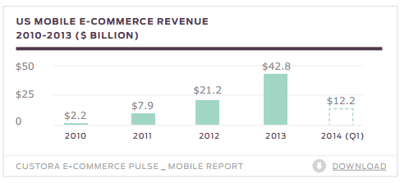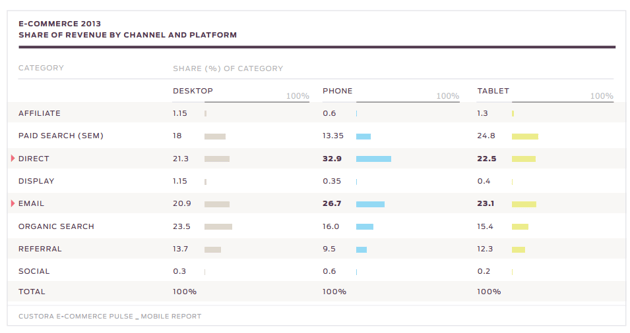Prediction: Mobile Commerce will Hit $50 Billion in Sales

The percentage of traffic coming to ecommerce sites from mobile devices jumped from 3 percent to nearly 37 percent in the past four years, according to data from Custora's new Ecommerce Pulse Mobile Report.
The report, which analyzed data from more than 100 retailers, 70 million consumers and $10 billion in transaction revenue, also found that U.S. mobile ecommerce sales grew from $2 billion in 2010 to $43 billion in 2013. Because of this, it is forecasted that mobile commerce will hit $50 billion in sales in 2014. 
"Retail is changing, and cross-device shopping is at the heart of the change. High-value, repeat customers are now three times more likely to be cross-device shoppers than they were in early 2012. The fastest-growing retail brands segment their customer base, and know that different customer segments have unique device preferences, which often translate to varied product category preferences and specific purchasing patterns," said Corey Pierson, CEO of Custora. "Mobile commerce continues to grow at an astounding rate. It's only a matter of time until mobile orders represent the majority of online commerce. Meanwhile, as mobile is growing, the landscape is dramatically changing. Mobile shopping used to be synonymous with Apple, but that's no longer the case. Samsung is truly making a dent in mobile shopping, and Amazon Fire is growing quickly."
One of the most interesting data points from the study reveals that cross-device shoppers are a small, yet growing, segment. For example, only 12 percent of customers made online purchases on more than one device type in Q1 2014. Twelve percent, however, is a significant increase from just 4 percent in 2012. It is also important to note that Custora's report says cross-device shoppers are 19 percent more valuable than the average single-device shopper in terms of customer lifetime value (CLV).
Other highlights from the report show that when it comes to marketing tactics, email drives more mobile purchases than social media. For instance, email marketing drove 27 percent of sales on mobile phones and 23 percent of sales on tablets, while social media only accounted for 0.6 percent of sales on phones and 0.2 percent on tablets.









